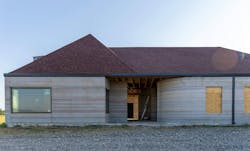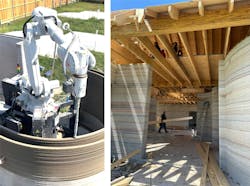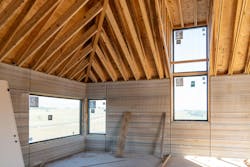3D Printing Cement Alternative Boasts 92% Fewer Emissions
In the tiny Texas town of Round Top, about 80 miles east of Austin, tens of thousands of treasure hunters gather several times a year for the region’s most renowned antique fairs. Soon, some of those visitors will be able to stay in what’s being billed as the world’s first near-zero-carbon, 3D-printed homes.
Eco Material Technologies, a Utah-based producer of sustainable cement alternatives, and Hive 3D, a Texas-based automated construction company, have partnered to build five vacation rentals in Round Top. Called The Casitas @ The Halles, the development’s units have been 3D printed with an Eco Material cement mixture called PozzoCEM Vite—which the company says has 92% fewer emissions than traditional cement.
3D Printing Material as a Cement Alternative
For all the attention that 3D printed homes are attracting as a faster, cheaper way to build housing, they typically rely on cement—which accounts for about 8% of global CO2 emissions each year. To replace traditional cement, Eco Material uses fly ash and other pozzolanic materials.
“By utilizing these mixtures, Eco Material’s green cement products can be manufactured at room temperature, instead of with high heat like traditional portland cement, drastically reducing emissions in the process,” explains Grant Quasha, CEO, Eco Material Technologies.
According to Eco Material, its product is not just more sustainable than traditional cement. It’s also stronger, more durable, and longer lasting. And it sets much faster—in just a few minutes. “This allows for the rapid construction of sustainable homes,” Quasha says.
Round Top Homes Built With Eco Material's 3D Printing Mortar
For the Round Top homes, Hive 3D worked with CyBe Construction to develop a small, mobile construction printer and mixing system that uses Eco Material’s cement replacement at high speed and quality. The printing mortar is mixed on-site with local aggregates at a much lower cost than other 3D printing mortars, according to Timothy Lankau, CEO, Hive 3D.
“These small homes … are more sustainable, more cost-effective, and built in a much shorter timeframe” than traditionally built homes, says Lankau, adding that his company’s building process is 30% to 40% less expensive.
It took Hive 3D just three to four days to print each Casitas home. It then takes about two months to get the homes ready for move-in, following the installation of electricity, plumbing, windows, and other components. (The Casitas units will be complete in a couple of months, Lankau says.)
In addition to the walls, Hive 3D printed the homes’ outdoor furniture and counter bases. And it used a proprietary cement foam mixture to insulate the homes.
The Casitas homes range in size from just 400 to 900 square feet and include studio, one-bedroom, and two-bedroom models. “These homes have been built for use as short-term, Airbnb-style rentals for tourists who visit Round Top for the festival season,” Lankau says of the homes’ size.
Starred Sky Development, Hive 3D’s development and marketing partner, will operate the homes as short-term rentals. (Hive 3D chose Round Top partly because it’s Starred Sky’s home base, Lankau says.)
The Round Top project follows Hive 3D’s printing of a 3,150-square-foot single-family home in Brenham, Texas. For that home, Hive 3D used another Eco Material product called PozzoSlag. Developed over the last decade, PozzoSlag, which has been used in infrastructure projects such as roads and bridges, replaces 50% of the traditional portland cement in concrete. By comparison, the more recently developed PozzoCEM Vite, used for The Casitas @ The Halles, replaces 100% of portland cement in concrete.
While Eco Material describes the cement used in Round Top as “near zero,” Quasha says the company expects to have a completely zero-carbon product for similar housing projects in the near future. And over the next year, Lankau says, Hive 3D and Eco Material plan to build dozens of 3D-printed houses.



